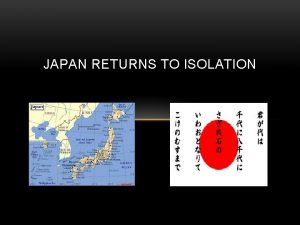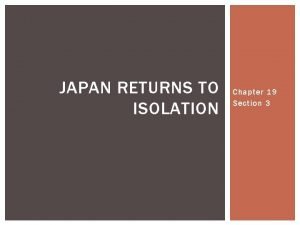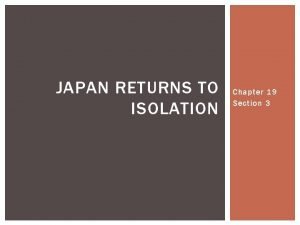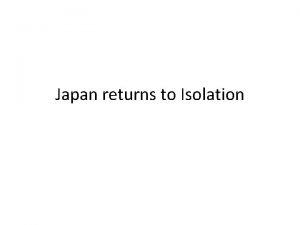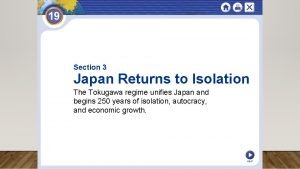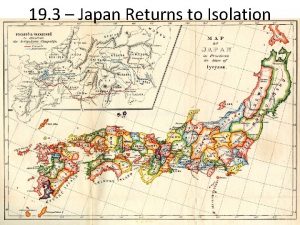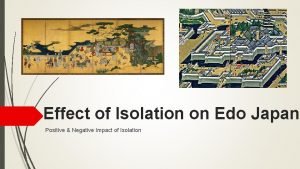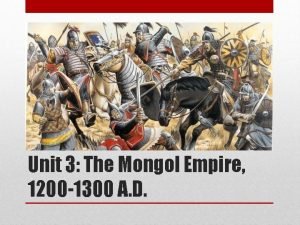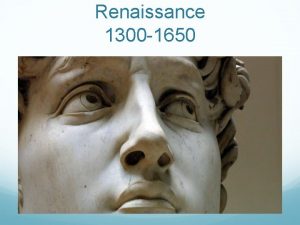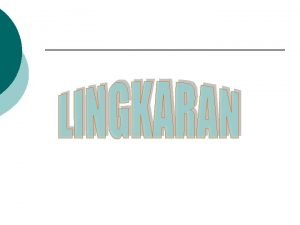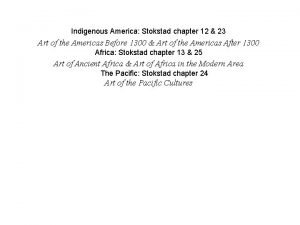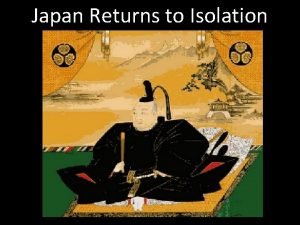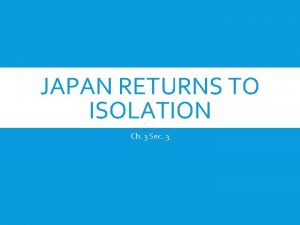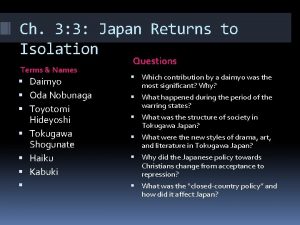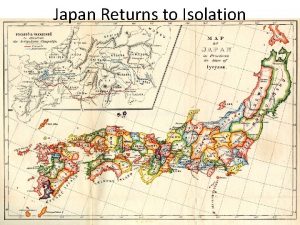JAPAN RETURNS TO ISOLATION PRIOR HISTORY 1300 s











- Slides: 11

JAPAN RETURNS TO ISOLATION

PRIOR HISTORY • 1300 s unity/peace that had been achieved broke down • “Shoguns” or military leaders in North & South fought for power • Economic/political unrest • Centuries before Japan would be unified again

FEUDALISM • Civil War- 1467 • Shattered old feudal system • Country collapsed in chaos • Power shifted from military shogun to territorial lords • Time period is known as the Sengoku, or “Warring States” period • Daimyo- “great name” • Military cheiftan • Offered peasants & others protection for their loyalty • Emperor @ Kyoto had title but not power

DAIMYO’S SEIZE CONTROL • • Daimyo- “great name” Military chieftains Offered peasants & others protection for their loyalty Kyoto- Japan’s capital • Emperor had title but did not have control of the country • Built fortified castles & created small armies of samurai warriors on horses • Added foot soldiers with guns (muskets) • Fought rival Daimyo for land • Caused disorder throughout the land

RESTORING ORDER • Daimyo sought to take control of the entire country • Oda Nobunaga • Defeated rivals & seized imperial capital in Kyoto in 1568 • Wanted to eliminate any remaining Daimyo • “Rule the empire by force” • 1575 - Crushed an enemy force of samurai calvary • 1 st time guns had been used effectively in battle in Japan • Not able to unify Japan • Commited Seppuku- ritual death of a samurai when his general turned on him

TOYOTOMI HIDEYOSHI • Nobunaga’s best general • Continued fallen leader’s mission • Set out to kill daimyo that remained hostile • 1590 - united Japan under one rule through diplomacy and conquest • Led campaign against Koreans & Ming (Chinese) allies • Planned to eventually conquer China • Died in 1598 - troops withdrew from China

TOKUGAWA UNITES JAPAN • Earned loyalty of daimyo throughout Japan • Became sole ruler or shogun • Moved capital to Edo- power base • Small fishing village • Eventually became Tokyo • Daimyo still ruled at the local level • Tokugawa’s Plan • Daimyo had to live in the capital ever other year • During the other years they had to leave their families in the capital • Rule by law, not by the sword • Tokugawa Shogunate- system of rule until 1867

TOKUGAWA LIFE IN JAPAN • Society Pyramid 1. Shogun- supreme military commander 2. Daimyo- land holding samurai 3. Samurai 4. Peasants/Artisans- 4/5 population 5. Merchants • Confucian Values • Ideal society depended on agriculture not business • Farmers- ideal citizens • Peasant farmers carried majority of tax burden

TOKUGAWA LIFE IN JAPAN • Shift to urban society • Edo (Tokyo) grown from small village to largest city in the world • More than a million people • Women • Employment for women increased • Entertainment, textile manufacturing, publishing • Majority still worked in the field, managed the home, & children • Culture • Traditional culture thrived • Haiku- new type of fiction (poetry) • Kabuki- actors in elaborate costumes using music, dance & mime

EUROPEANS ARRIVE • During “Warring states period” • Portugal was 1 st • Welcomed traders & missionaries • Clocks, eyeglasses, tobacco, firearms, & items from Europe • Daimyo took interest in Portuguese guns/cannons • Missionaries • Converted approx. 300, 000 Japanese by 1600 • Tokugawa became worried because some missionaries scorned traditional Japanese beliefs • Feared losing European Business • 1612 - Banned Christianity from country • European missionaries were killed or driven out of Japan

CLOSED COUNTRY POLICY • Shoguns realized they could safely exclude merchants & missionaries from Japan • 1639 - Leaders sealed the country’s borders • No European influence • Nagasaki- Only port open foreign trade • Only open to Chinese & Dutch • Shoguns controlled Nagasaki- monopoly on foreign trade • More than 200 years Japan remained closed to Europeans • Japanese forbidden to leave so they couldn’t bring back European items • Japan develops into self-sufficient country
 Japan returns to isolation
Japan returns to isolation Chapter 19 section 3 japan returns to isolation answer key
Chapter 19 section 3 japan returns to isolation answer key Chapter 19 section 3 japan returns to isolation
Chapter 19 section 3 japan returns to isolation Japan returns to isolation
Japan returns to isolation Japan returns to isolation
Japan returns to isolation Japan returns to isolation
Japan returns to isolation Did isolation have a positive or negative effect on japan?
Did isolation have a positive or negative effect on japan? The mongol empire spans eurasia worksheet answer key
The mongol empire spans eurasia worksheet answer key 1650-1300
1650-1300 Besar salah satu sudut pusat segi 12 beraturan adalah
Besar salah satu sudut pusat segi 12 beraturan adalah Besar sudut 1350 = … .
Besar sudut 1350 = … . Art of the americas before 1300
Art of the americas before 1300
